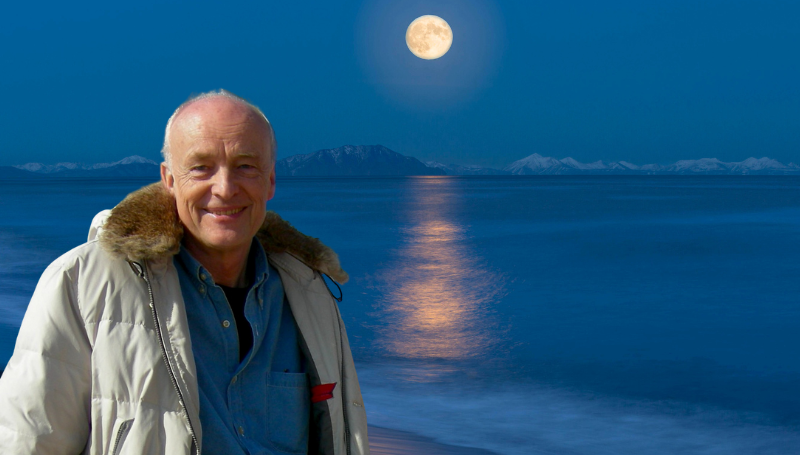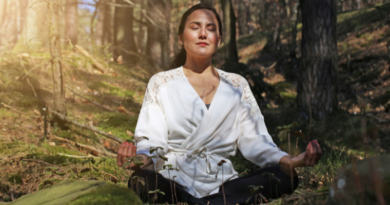Deuter’s Mångata: A sonic journey into tranquility, nature, and the wonders of the universe
(Global Heart | Esther Haasnoot) For over four decades, Deuter’s transcendent music has provided solace, healing, and a profound sense of connection. Now, the legendary New Age artist invites us once more into his sonic world with his new album, “Mångata”, a beautiful exploration of tranquility, nature, and the wonders of the Universe. We had the privilege of an extensive conversation with Deuter about “Mångata” and much more. You won’t want to miss this interview.
Mångata celebrates our bond with nature and the cosmos
“The soothing sound of Mångata is very heart-driven, melodic, and expresses a deep connection with the natural elements. As we’ve come to expect, Deuter blends ambient, world, and new age music into something refreshingly new.” Deuter’s inspiration for Mångata can be seen as an extension of his lifelong quest to use music as a tool for personal and collective healing, promoting a sense of inner peace and cosmic harmony, and expressing a deep connection with the natural world by receiving inspiration from it. He is known for creating music that encourages inner peace, healing, and slowing down the madness of this world. The album invites the listener to feel both grounded and uplifted, much like the connection between the earth and the moon’s reflected light.”
— Robin B. James
An Interview with Deuter about his new album: “Mångata” by Esther Haasnoot
Esther Haasnoot: Deuter, let’s go back to the beginning. What sparked your passion and made you think, “Yes, I want to make a career in music”? How did it all start for you?
Deuter: I think I was living on a different planet when I decided to come here and make some music. Now, there are really two beginnings. One is when I was a child, a really small child, and I heard a flute for the first time. There was like a light coming into the relative darkness after the war, the darkness in Germany. The flute was like a breakthrough of sunshine in the dark clouds for me. As soon as it was possible, I started to play around with the flute, and then I found the guitar. I started teaching it to myself and then got some flute lessons. The main start for me in making music the way I do now was totally different. I was missing something, a certain type of music, and I could never hear it anywhere. I wanted to hear some music that was soothing, friendly, and harmonious. I found it in endings of other pieces, like the adagio part of classical music, where things are quiet, where things are relaxed before it gets dramatic again. I always liked that part where the music fades into silence because in the silence, you suddenly become aware of the silence. The music ends for a while, and you can listen to the silence and, with it, to the feelings of silence. So I decided, “Okay, if nobody makes it, I will make it.” That’s how it started.
Esther Haanoot: You’ve pioneered New Age music for over 40 years, connecting East and West. How did you first become interested in Eastern musical traditions and philosophies, and how do you consciously weave them into your music?
Deuter: Not really. It was the sixties, and it was just in fashion. Indian music opened up in the Western world. The Beatles had their famous album, Sgt. Pepper’s Lonely Hearts Club Band, and I’m not sure if it was the first time I heard some sitar playing. Anyway, I heard it at that time somewhere. I heard a sitar, and I was totally fascinated by the sound of the sitar. I went to Paris and found one for sale and bought it, and started learning to play the sitar.

Esther Haasnoot: The title of your beautiful new album, “Mångata,” is the Swedish word for the “moon path,” describing the reflection of the moon’s light on water. What drew you to this specific image and concept for your latest work? What deeper meaning does “Mångata” hold for you personally?
Deuter: Personally, it’s the picture of the moon on water. Sometimes I have a picture or experience in life, or I see something in nature, and it creates the music, and sometimes I make a piece of music, and it creates a picture. It creates a memory of something. And I don’t remember how I came across the word Mångata. I liked the Swedish language. I have Swedish friends, and I must have read the word somewhere, and I like the meaning of it. I like that the Swedes sometimes have a single word for a complex description—a situation, a picture—. So Mångata is the moon, the light of the moon, the softness of the moonlight on something, on the water. And for me, that fits with a certain type of music which I like.
Esther Haasnoot: You mentioned in another interview, “For me, all the instruments I’m using are basically like colors in a painting.” Can you elaborate on this analogy? How do you choose your “colors” for a particular piece, and what kind of “canvases” (themes, emotions, intentions) do you typically work on?

Deuter: That’s basically the fun part for me. It’s really like painting. First of all, a painter is usually by themselves when they are painting, and that’s very much my thing. I have the canvas there, which is not a canvas, but it is like a canvas. And I try out a composition, and then I try out different colors, and the instruments are for me colors, and I mix them together. I try out this color, that color, and I paint over it and use a different color. And so it’s really like painting for me, but with sound. Painting with sound.
Esther Haasnoot: You create your music in your home studio in the New Mexico forest, which you share with birds, deer, bears, roadrunners, snakes, coyotes, and your own bee colony. How does this deep connection with nature inspire your music?
Deuter: I have no idea, really, it’s just the way I am. But first of all, I’m not sharing it with the bears. They are not welcome here. They destroy everything. I just share with bees and birds and flowers. But bears are not really welcome. I did live in the city and I didn’t like it. I don’t like the city life. Nature has its natural rhythm, which, because it’s nature, it’s healthy in a way, but it can also be very stressful if you live in a storm and you get flooded. So it’s the frequency of nature that I love. I like to be in a city sometimes, and I like to explore what the city has to offer. But living for me is definitely in nature. There are not so many people here, and the big sky. I lived in southern France, which also had a pretty big sky, a blue sky. That’s why many painters moved there. And the sky here is even bigger, and it’s more empty than it is somewhere else. I experienced it also in Iraq and Afghanistan, this big sky. I think it has to do with the desert, with the humidity in the air, that it gives this impression. But that’s what I definitely love here, that I can drive a few minutes from my house and find totally empty landscapes. Space. Space. I love space. I love space in the music, and I love the space outside in my life.
Esther Haasnoot: Your music is often described as meditative. From Feng Shui principles in the layout of your studio to the Zen-like furniture you’ve created, your creative space reflects a mindful intention. How does this thoughtful design influence the mood and fluidity of your music?

Deuter: Well, I can be totally fascinated by something. The way I understand this life here in our universe, there is something and there’s nothing. And what something is, we all know—it’s right in front of us. But the nothingness is the fascinating part, which is in sound. In the sound world, it would be silence. Now, the silence is there all the time, but we are usually not aware of it. And I was always fascinated by having a sound, listening to the sound, and letting it slowly disappear into silence. And by the disappearing in the silence, you become aware of the silence, and you feel the silence for at least a while. Time is involved there. And I always loved the ending of pieces. No, you cannot just have endings. You have to have something going on. But then the ending of something is to me totally fascinating because it creates the silence which was there before, but suddenly it becomes audible.
Esther Haasnoot: What role do you think sound, energies, and frequencies play in balancing mind-body-spirit health, and how do you incorporate this understanding into your music? For example, do you use Solfeggio frequencies, binaural beats, or other specific frequency-based healing systems in your work?
Deuter: No, I don’t do this. That’s an approach some people do. I don’t have that. I just follow my feelings. It totally comes from the inside, not from the outside, with some physicist measuring somebody’s brain. I don’t care much about that.
Esther Haasnoot: Now that we know you follow your intuition rather than specific systems, can you describe your creative process? When a new song begins, how does it manifest for you? Does it arrive as a feeling, a single melody, or a fully formed idea, almost like it’s “knocking on the door”?
Deuter: Yeah. That’s not so easy to figure that out. That’s all of it. Sometimes it’s a melody which comes. I can hear it. Sometimes it’s a feeling, an idea of something. And I can hear the music in a certain way, not like acoustically, but I can hear it on a different frequency. But I know what it should be. And then I try to translate it into the audible world and try to get as close as I can to the one I hear inside, which is not always possible.
Esther Haasnoot: In a world that often feels disconnected and chaotic, what do you hope listeners experience when they immerse themselves in “Mångata”?
Deuter: Well, that depends on the people, on the person who listens to it. I have gotten a lot of feedback over the years, and most people experience a feeling of well-being, of joy, of healing emotional dramas. But I don’t think about it like this. I just hope somebody can enjoy what I’m doing the way I enjoy doing it. So I hope some of that frequency carries the music to the listener.

About CG Deuter
Lovingly referred to simply as Deuter around the world, his music has soothed, uplifted, and educated his many fans for decades. Deuter has recorded and released over 60 albums. He is fluent on an ever-expanding array of instruments, including the flute, recorder, guitar, koto, shakuhachi, sitar, Tibetan singing bowls, santoor, bouzouki, piano, and keyboards. For more information or to connect with Deuter visit: Website, Instagram, Spotify, and Facebook.
Source: Global Heart
You may also like:
Still: Find yourself in blissful serenity with Steinway artist Ann Sweeten




